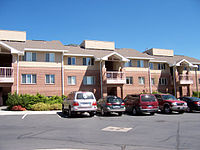- List of Brigham Young University residence halls
-
This is a list of residential buildings at Brigham Young University. Besides the actual buildings where people live, dining facilities, housing area offices, laundry facilities and other buildings directly connected with the residence halls are included in this list. Residential buildings at Brigham Young University include three single-student residence hall centers, a foreign language student residence facility, and married-student housing at Wymount Terrace.
Contents
Foreign Language Student Residence
Building Abbr. Image Yr. Occ. Notes References Foreign Language Student Residence FLSR 1992 The on-campus complex consists of 25 apartments for men and women, learning nine different languages: Arabic, Chinese, French, German, Italian, Japanese, Portuguese, Russian, and Spanish. Residents of these apartments agree to speak only their apartment's assigned language during the school year while in the apartment. This immersion experience is available in nine languages, and students are accompanied by a native resident throughout the year to enhance the experience. [1][2][3] Helaman Halls
40°15′8″N 111°39′11″W / 40.25222°N 111.65306°W
Construction of Helaman Halls followed soon after the completion of Heritage Halls, with the first five buildings completed in 1958, three more added by 1970, and the ninth hall in 2010.[4][5]Helaman Halls was originally an all-men complex, but now consists of five buildings for women, and four buildings for men. Although there are basic kitchen facilities in the basement lobby of each hall, residents are required to have a meal plan, and the majority of their meals are eaten in the area central building: The Cannon Center. Because of its close proximity to the athletic facilities and all-you-can-eat dining, many Freshman athletes choose to live in Helaman Halls.[5]
Helaman Halls is located on the northwest corner of campus. Living style consists of two people per room, with 22 rooms on each floor, with six floors (in three stories) per building. Helaman Halls currently has housing for just over 2,100 students. The Halls recently underwent a 12 year renovation spanning 1991 and through 2003.[6] A new men's hall is under construction between Merrill and May halls.[5]
There are nine individual living buildings. They each are named after a well-known Latter-day Saint man or woman and assigned a letter. The buildings in the Helaman Halls complex include:
Building Abbr. Image Yr. Occ. Notes References Cannon (George Q.) Center CANC 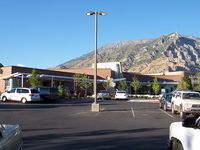
2008 The Cannon Center acts as a central building for Helaman Halls residents, providing areas for activities such as dances, as well as providing mail services and checking out athletic equipment such as basketballs and volleyballs. Besides this, The Commons at the Cannon Center provide meal services for the residents of Helaman halls, as well as the rest of campus; it serves as the main cafeteria for BYU since the 2008 closing of the Morris Center. [1][2][7] Helaman Halls (B) Hinckley (Ira N.) Hall HLB 
1958 Named after Ira N. Hinckley, the grandfather of the late President of The Church of Jesus Christ of Latter-day Saints Gordon B. Hinckley, and an acquaintance of Joseph Smith Jr. [1][2][8] Helaman Halls (C) Chipman (Steven L.) Hall HLC 
1958 Named for Stephen L. Chipman, Mormon religious leader in north Utah County [1][2] Helaman Halls (D) John (David) Hall HLD 
1958 Named after David John, father-in-law of Benjamin Cluff (third president of Brigham Young University) and vice-president of the Brigham Young Academy and Brigham Young University Board of Trustees. [1][2][9] Helaman Halls (E) Taylor (Thomas N.) Hall HLE 
1958 Named after Thomas N. Taylor, mayor of Provo, Utah from 1900 to 1903 and alumnus of Brigham Young Academy. [1][2] Helaman Halls (F) Stover (Walter F.) Hall HLF 
1958 Named after Walter F. Stover who donated all the mattresses and box springs for Helaman Halls. Stover was a native of Germany and served as president of the East German mission immediately after World War II. He also served on the General Church Welfare Committee of The Church of Jesus Christ of Latter-day Saints. [1][2][10][11] Helaman Halls (G) Budge (William) Hall HLG 
1959 Named for William Budge, the man who baptized Karl G. Maeser, often viewed as the founder of BYU although that distinction is not held by any one person, see History of Brigham Young University [1][2] Helaman Halls (H) Merrill (Marriner Wood) Hall HLH 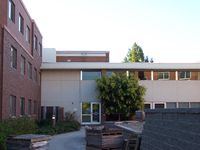
1959 Named after LDS apostle Marriner W. Merrill [1][2] Helaman Halls (I) May (Jean Fossum) Hall HLI 
1970 Named after Jean Fossum May (1906–1969), the head resident of Stover Hall for the last 10 years of her life. May had served a mission for the LDS Church when she was a little more than 20 years old. She greatly encouraged residents in her hall to serve missions and faithfully corresponded with them while they were on missions. [1][2][12][13] Helaman Halls (J) "Building 9" HLJ 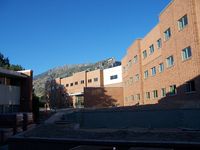
2010 [1][2] The current Cannon Center is the second building of this name. It was built while the old Cannon Center was still in operation and so is located slightly north and east of the old building. The old Cannon center in general filled the same function and role as the current building.
Heritage Halls
40°15′5″N 111°38′40″W / 40.25139°N 111.64444°W
Heritage Halls is a complex of dorms that consist of 24 buildings. It is communal style living for unmarried students. Students share a kitchen and a common area. Built in 1953, Heritage Halls are the oldest dorms on campus. It is located on the East side of campus. Students that live in the Heritage Halls attend church in the Provo Utah YSA 4th Stake on Brigham Young University campus. The living arrangements in Heritage are similar to those of an apartment. Heritage Halls was originally a women-only dorm. Now, 11 dorms are for men and 13 for women.Heritage Halls is a twenty-four-building housing complex on campus which offers apartment-style living. Six of the buildings were built in 1952, and another six in 1954. The complex was dedicated on May 26, 1954.[14] The halls received their collective name through a contest among residents. Twenty-two of the separate buildings are named after notable Latter-day Saint women. Originally, these halls housed only female residents. Today, however, the halls house both male and female students, divided by gender into separate buildings. Each of the original buildings has ten units capable of housing six people each.[15][16] Halls HR17 through HR24 were constructed with a third floor that added another four six-person apartments. In 2011, building HR01 was demolished to allow the utility tunnels to be extended. HR20 was also taken out of service. Two new, much larger buildings (HR25 and HR28) were completed and first occupied in August 2011. These new buildings each have four floors. HR25 has 186 beds and HR28 has 234 beds. HR26 and HR27 are under construction as of September 2011 with an anticipated occupancy in January 2012.
There are 24 individual living buildings as well as a main building (Central Building.) They each are named after a well-known Latter-day Saint woman and assigned a number. The buildings in the Heritage Halls complex include:
Building Abbr. Image Yr. Occ. Notes References Heritage Halls Central Building HRCN 
1983 This building contain a computer lab and the administrative offices for the complex. [1][2] Heritage Halls (01) Bowen (Emma Lucy Gates) Hall HR01 
1953 Named after Emma Lucy Gates Bowen. On May 19, 2011 the BYU Daily Universe reported the school's plans to demolish Bowen Hall to make way for a new steam service tunnel between the Harris Fine Arts Center and 900 East. [1][2] Heritage Halls (02) Broadbent (Mima Murdock) Hall HR02 
1953 Mima Melissa Murdock Braodbent (1879–1957) was one of the women chosen to have a hall named after her because she was an example of a good homemaker. Mima and her husband David A. Braodbent were the parents of 14 children, 12 of whom lived to maturity. All 12 of these graduated from college, and arguably more laudably from a Mormon point-of-view all 12 were married in the Temple. Mima was the Utah mother-of-the year in 1948. [1][2][17][18] Heritage Halls (03) Felt (Louie B.) Hall HR03 
1953 Named after Louie B. Felt [1][2] Heritage Halls (04) Fox (Ruth May) Hall HR04 
1953 Named after Ruth May Fox [1][2] Heritage Halls (05) Horne (Alice Merrill) Hall HR05 
1953 Alice Merrill Horne (1868–1948) was a native of Fillmore, Utah and a prominent Utah artist. [1][2] Heritage Halls (06) Harris (Estella Spilsbury) Hall HR06 
1953 Estella Spilsbury Harris was the wife of Franklin S. Harris and thus the longest-serving first lady of BYU. [1][2] Heritage Halls (07) Maeser (Anna Mieth) Hall HR07 
1953 Named for Anna Mieth Maeser, wife of Karl G. Maeser, and thus first lady of what is now BYU from 1876–1892 [1][2] Heritage Halls (08) Penrose (Romania Pratt) Hall HR08 
1953 Named for Romania Pratt Penrose, first female Utahn to get an MD and wife of Charles W. Penrose, who was a professor at BYU for a short time before becoming an LDS Apostle [1][2] Heritage Halls (09) Rogers (Aurelia S.) Hall HR09 
1953 Named after Aurelia Spencer Rogers, mother of the LDS Primary program for children and daughter of Orson Spencer, the first chacnellor of what is today the University of Utah [1][2] Heritage Halls (10) Richards (Alice Robinson) Hall HR10 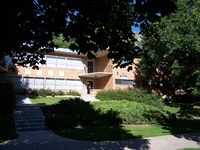
1953 Named after Alice Robinson Richards, wife of Apostle George F. Richards and mother of apostle Legrand Richards, as well as 14 other children. [1][2] Heritage Halls (11) Shipp (Ellis Reynolds) Hall HR11 
1953 Named after Ellis Reynolds Shipp [1][2] Heritage Halls (12) Robinson (Louise Yates) Hall HR12 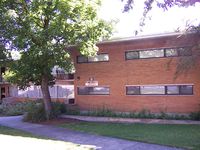
1953 Named for Louise Y. Robison. [1][2] Heritage Halls (13) Snow (Eliza R.) Hall HR13 
1953 Named after Eliza R. Snow [1][2] Heritage Halls (14) Smith (Lucy Mack) Hall HR14 
1953 Named after Lucy Mack Smith [1][2] Heritage Halls (15) Wells (Emmeline B.) Hall HR15 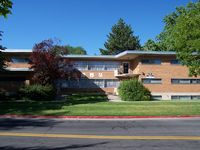
1953 Named after Emmeline B. Wells [1][2] Heritage Halls (16) Smith (Mary Fielding) Hall HR16 
1953 Named after Mary Fielding Smith [1][2] Heritage Halls (17) Carroll (Elsie C.) Hall HR17 
1956 Named after Elsie Chamberlain Carroll (1882–1967) who a BYU English professor and an author and poet, most of her works being published in LDS Church magazines. [1][2][19] Heritage Halls (18) Fugal (Lavina C.) Hall HR18 
1956 Lavina Christensen Fugal (1879–1969) was American Mother of the Year in 1955. A graduate of Brigham Young Academy, Lavina taught school to help support her future husband, Jens Peter Fugal, while he was on an LDS mission in Denmark. The Fugals had eight children. She served in various LDS Auxiliary organization positions, was a member of the Farm Bureau, and served on the Utah County planning commission also for a time as head of the Pleasant Grove Board of Health. [1][2][20][21] Heritage Halls (19) Gates (Susa Young) Hall HR19 
1956 Named after Emma Gates and Susa Young Gates [1][2] Heritage Halls (20) Kimball (Vilate M.) Hall HR20 
1956 Named after Vilate M. Kimball, the first wife of Heber C. Kimball, Brigham Young's best friend and also first counselor to Brigham Young in the first presidency until Heber C. Kimball died [1][2] Heritage Halls (21) Richards (Emily S.) Hall HR21 
1956 Named after Emily Sophia Tanner Richards (1850–1929), the wife of Franklin S. Richards and a suffragist. She was a delegate for the Relief Society at the first International Council of Women. Emily served for many years on the Relief Society General Board. She and Franklin were the parents of six children. [1][2] Heritage Halls (22) Tingey (Martha H.) Hall HR22 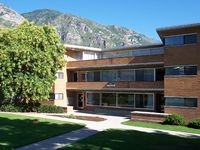
1956 Named after Martha H. Tingey [1][2] Heritage Halls (23) Whitney (Elizabeth Ann) Hall HR23 
1956 Named for Elizabeth Ann Smith Whitney, the wife of Newel K. Whitney, the 2nd presiding bishop of the Church. [1][2] Heritage Halls (24) Young (Zina D. H.) Hall HR24 
1956 Named after Zina D. H. Young [1][2] Heritage Halls 25 HR25 2011 Heritage Halls 26 HR26 2012 Heritage Halls 27 HR27 2012 Heritage Halls 28 HR28 2011 Wymount Terrace
Wymount Terrace is the family housing unit for married students and is located on the northeast side of campus. It consists of South Wymount (24 three-story apartment buildings) and North Wymount (48 two-story apartment buildings). The buildings are arranged in quadrangles that enclose lawn and playground areas. The complex started as a trailer park and was converted into apartment housing in the 1960s.[22] The buildings in the Wymount Terrace complex include:
Building Abbr. Image Yr. Occ. Notes References Wymount Terrace Administration Building WOAB 1962 [1][2] Wymount Terrace Laundry Building #1 W0L1 1962 [1][2] Wymount Terrace Laundry Building #2 W0L2 1962 [1][2] Wymount Terrace Laundry Building #3 W0L3 1962 [1][2] Wymount Terrace Laundry Building #4 W0L4 1979 [1][2] Wymount Terrace Laundry Building #5 W0L5 1985 [1][2] Wymount Terrace Multi-Purpose Center W0MP 1980 This is where many of the wards consisting of Wymont residents hold church meetings. The other main location for church meetings is the stake center on 9th east between the south end of Wymount and the rest of BYU campus. [1][2] Wymount Terrace (W01A) Kimball, (Sarah M.) W01A 1962 Named for Sarah M. Kimball. [1][2] Wymount Terrace (W01B) Reynolds, (Alice Louise) W01B 1962 Alice Louise Reynolds was a professor of English at BYU during the early 20th century. [1][2] Wymount Terrace (W01C) Smith (Julia Lambson) W01C 1962 Julia Lambson Smith was a wife of Joseph F. Smith and the mother of Joseph Fielding Smith. [1][2] Wymount Terrace (W02A) Bennion (Samuel O.) W02A 1962 Named for Samuel O. Bennion [1][2] Wymount Terrace (W02B) Ivins (Antoine R.) W02B 1962 Named for Antoine R. Ivins [1][2] Wymount Terrace (W02C) Kimball (J. Golden) W02C 1962 Named for J. Golden Kimball [1][2] Wymount Terrace (W02D) Roberts (Brigham H.) W02D 1962 Named for B. H. Roberts [1][2] Wymount Terrace (W03A) Williams (Helen Spencer) W03A 1963 Helen Spencer Williams, often called Helen S. Williams, was the first counselor in the YWMIA General Presidency of the Church of Jesus Christ of Latter-day Saints from 1937-1944. She was also a writer and columnists, writing for the Deseret News, the Improvement Era and the Relief Society Magazine. [1][2][23] Wymount Terrace (W04A) Nibley (Charles W.) W04A 1963 Named for Charles W. Nibley [1][2] Wymount Terrace (W04B) Reynolds (George) W04B 1963 Named for Geoerge Reynolds [1][2] Wymount Terrace (W04C) Wirthlin (Joseph L.) W04C 1963 Named for Joseph L. Wirthlin [1][2] Wymount Terrace (W04D) Young (Levi Edgar) W04D 1963 Named for Levi Edgar Young. [1][2] Wymount Terrace (W05A) Clayton (William) W05A 1963 Named for LDS hymnwriter William Clayton. [1][2] Wymount Terrace (W05B) Mcclellan (John J.) W05B 1963 Named for John J. McClellan. [1][2] Wymount Terrace (W05C) Pratt (Orson) W05C 1963 Named for Orson Pratt. [1][2] Wymount Terrace (W05D) Stephens (Evan) W05D 1963 Named for former Mormon Tabernacle Choir director Evan Stephens [1][2] Wymount Terrace (W06A) Dixon (Henry Aldous) W06A 1963 Named for Henry Aldous Dixon a prominent Utah educator and politician. [1][2] Wymount Terrace (W06B) Hamblin (Jacob) W06B 1963 Named for Mormon missionary to the Native Americans Jacob Hamblin. [1][2] Wymount Terrace (W06C) Sutherland (George F.) W06C 1963 One of very few buildings at BYU named for a non-Mormon, in this case Brigham Young Academy graduate and later United States Supreme Court justice George F. Sutherland [1][2] Wymount Terrace (W06D) Swensen (John C.) W06D 1963 Named for John C. Swensen, a BYU professor for 54 years. [1][2] Wymount Terrace (W07A) Critchlow, Jr. (William J.) W07A 1962 Named for William J. Critchlow Jr., a prominent LDS leader in Ogden and later a General Authority as an Assistant to the Twelve. [1][2] Wymount Terrace (W07B) Longden (John) W07B 1962 Named for John Longden (Mormon). [1][2] Wymount Terrace (W07C) McKay (Thomas E.) W07C 1962 Named for Thomas E. McKay, a brother of David O. McKay who also served as a general authority. [1][2] Wymount Terrace (W07D) Smith (Nicholas G.) W07D 1962 Named for Nicholas G. Smith. [1][2] Wymount Terrace (W08A) W08A 1979 [1][2] Wymount Terrace (W08B) W08B 1979 [1][2] Wymount Terrace (W08C) W08C 1979 [1][2] Wymount Terrace (W08D) W08D 1979 [1][2] Wymount Terrace (W08E) W08E 1979 [1][2] Wymount Terrace (W08F) W08F 1979 [1][2] Wymount Terrace (W09A) W09A 1979 [1][2] Wymount Terrace (W09B) W09B 1979 [1][2] Wymount Terrace (W09C) W09C 1979 [1][2] Wymount Terrace (W09D) W09D 1979 [1][2] Wymount Terrace (W10A) W10A 1979 [1][2] Wymount Terrace (W10B) W10B 1979 [1][2] Wymount Terrace (W10C) W10C 1979 [1][2] Wymount Terrace (W10D) W10D 1979 [1][2] Wymount Terrace (W10E) W10E 1979 [1][2] Wymount Terrace (W10F) W10F 1979 [1][2] Wymount Terrace (W11A) W11A 1979 [1][2] Wymount Terrace (W11B) W11B 1979 [1][2] Wymount Terrace (W11C) W11C 1979 [1][2] Wymount Terrace (W11D) W11D 1979 [1][2] Wymount Terrace (W11E) W11E 1979 [1][2] Wymount Terrace (W12A) W12A 1982 [1][2] Wymount Terrace (W12B) W12B 1982 [1][2] Wymount Terrace (W12C) W12C 1982 [1][2] Wymount Terrace (W12D) W12D 1982 [1][2] Wymount Terrace (W13A) W13A 1982 [1][2] Wymount Terrace (W13B) W13B 1982 [1][2] Wymount Terrace (W13C) W13C 1982 [1][2] Wymount Terrace (W13D) W13D 1982 [1][2] Wymount Terrace (W14A) W14A 1985 [1][2] Wymount Terrace (W14B) W14B 1985 [1][2] Wymount Terrace (W14C) W14C 1985 [1][2] Wymount Terrace (W14D) W14D 1985 [1][2] Wymount Terrace (W15A) W15A 1985 [1][2] Wymount Terrace (W15B) W15B 1985 [1][2] Wymount Terrace (W15C) W15C 1985 [1][2] Wymount Terrace (W15D) W15D 1985 [1][2] Wymount Terrace (W15E) W15E 1985 [1][2] Wymount Terrace (W16A) W16A 1992 [1][2] Wymount Terrace (W16B) W16B 1992 [1][2] Wymount Terrace (W16C) W16C 1992 [1][2] Wymount Terrace (W16D) W16D 1992 [1][2] Wymount Terrace (W16E) W16E 1992 [1][2] Wymount Terrace (W16F) W16F 1992 [1][2] Wymount Terrace (W16G) W16G 1992 [1][2] Wymount Terrace (W17A) W17A 1992 [1][2] Wymount Terrace (W17B) W17B 1992 [1][2] Wymount Terrace (W17C) W17C 1992 [1][2] Wyview Park
In 1971, Brigham Young University purchased a group of 150 mobile home units and set them up on a tract of land between University Avenue and 200 West from 1800 North to 2230 North to provide housing for married students. This project included 36 one-bedroom units, 78 two-bedroom units, and 36 three-bedroom units. There was a central building of 5,514 square feet (512.3 m2) which housed laundry facilities, and administrative offices, etc. This trailer park was demolished in 1997 to accommodate replacement married student apartments.[24]
The current complex includes 30 buildings which originally housed married student families, until the end of the summer of 2006, when the southern half of the residential park was converted into housing for singles and eventually the entire complex.[25] The buildings are arranged in quads with playgrounds and courts enclosed. The complex contains a laundromat, a convenience store, a BYU Creamery store, and a multipurpose building which houses the Wyview office and a chapel for LDS wards.[26] The buildings in the Wyview Park complex include:
Building Abbr. Image Yr. Occ. Notes References Wyview Park Central Building WPCB 1998 [1][2] Wyview Park Maintenance Bldg WPMB 1997 [1][2] Wyview Park Multi-Purpose Bldg WPMP 1998 [1][2] Wyview Park (WP01) WP01 1998 [1][2] Wyview Park (WP02) WP02 1998 [1][2] Wyview Park (WP03) WP03 1998 [1][2] Wyview Park (WP04) WP04 1998 [1][2] Wyview Park (WP05) WP05 1998 [1][2] Wyview Park (WP06) WP06 1998 [1][2] Wyview Park (WP07) WP07 1998 [1][2] Wyview Park (WP08) WP08 1998 [1][2] Wyview Park (WP09) WP09 1998 [1][2] Wyview Park (WP10) WP10 1998 [1][2] Wyview Park (WP11) WP11 1998 [1][2] Wyview Park (WP12) WP12 1998 [1][2] Wyview Park (WP13) WP13 1998 [1][2] Wyview Park (WP14) WP14 1998 [1][2] Wyview Park (WP15) WP15 1998 [1][2] Wyview Park (WP16) WP16 1998 [1][2] Wyview Park (WP17) WP17 1998 [1][2] Wyview Park (WP18) WP18 1998 [1][2] Wyview Park (WP19) WP19 1998 [1][2] Wyview Park (WP20) WP20 1998 [1][2] Wyview Park (WP21) WP21 1998 [1][2] Wyview Park (WP22) WP22 1998 [1][2] Wyview Park (WP23) WP23 1998 [1][2] Wyview Park (WP24) WP24 1998 [1][2] Wyview Park (WP25) WP25 1998 [1][2] Wyview Park (WP26) WP26 1998 [1][2] Wyview Park (WP27) WP27 1998 [1][2] Wyview Park (WP28) WP28 1998 [1][2] Wyview Park (WP29) WP29 1998 [1][2] Wyview Park (WP30) WP30 1998 [1][2] Previous Residential facilities
Allen Hall
One of the earliest student dormitories at BYU, Allen Hall, named for Ray Eugene Allen and his wife Inez Knight, was built in 1938. Originally it was a men's dormitory, but during World War II, a large influx of female students caused the university to make it a women's dorm. In 1962, the building ceased to be a student dormitory altogether, and was used as temporary housing for missionaries while the Church's Language Training Mission was under construction.[27] The success of Allen Hall led to immediate plans for another dormitory, Amanda Knight Hall, named for the wife of Jesse Knight. This served as a home for female students until it was also turned over to the Language Training Mission.[28]
BYA Boarding House
The BYA Boarding House was established in 1885 with Joseph B. Keeler as steward and Willard Done as presiding tutor. It had 24 residents in May of 1886 but there is no record of it after that date.[29]
Co-op Housing
In the years immediately after World War II BYU purchased several houses in Provo that it operated as co-operative residents before it was able to build resident halls on a large scale. Most of these houses were for female students.[30]
Deseret Towers
In 1965, BYU completed construction of Deseret Towers. "DT", as it is called by students, originally consisted of five towers, with a sixth (V Hall) added in 1969, and a seventh (W Hall) in the late seventies. The Towers were capable of housing over 2000 students. In December 2006, V and W Hall were torn down. The others followed in 2008 with demolition being completed in May 2008.[31][32][33]
Wymount Village
In 1946, during the postwar BYU growth, President McDonald purchased forty-eight buildings from a nearby Air Force station in order to house students. These buildings were called Wymount Village, and housed both married and single students until 1962.[34] Wymount Village was replaced by Wymount Terrace in that year, intended solely for students with young families. The 24 building complex contains a total of 462 apartments of varying sizes.[35] Wymont Village was located in the general vicinity of where the J. Reuben Clark Law School is today.
Wyview Village
This was another set of housing units purchased from the Federal Government. It was 150 pre-fabricated homes intended for Mountain Home Air Force Base. There units were practically new, with new appliances and many had never been lived in. They were sold as surplus by the government in Ocrtober of 1956, moved to Provo early in 1957 and ready for occupation by August 1957. They were located north-east of the present site of the Marriot Center.[36]
Notes
- ^ a b c d e f g h i j k l m n o p q r s t u v w x y z aa ab ac ad ae af ag ah ai aj ak al am an ao ap aq ar as at au av aw ax ay az ba bb bc bd be bf bg bh bi bj bk bl bm bn bo bp bq br bs bt bu bv bw bx by bz ca cb cc cd ce cf cg ch ci cj ck cl cm cn co cp cq cr cs ct cu cv cw cx cy cz da db dc dd de df dg dh di dj dk dl dm dn do dp dq dr ds dt du dv dw dx dy dz ea eb ec ed ee ef eg eh ei ej ek el em en eo ep eq er BYU Office of Space Management (January 2010), Building Inventory – Brigham Young University – January 2010, Provo, Utah, United States: Brigham Young University Press, http://plantwo.byu.edu/space/building_inventory.pdf
- ^ a b c d e f g h i j k l m n o p q r s t u v w x y z aa ab ac ad ae af ag ah ai aj ak al am an ao ap aq ar as at au av aw ax ay az ba bb bc bd be bf bg bh bi bj bk bl bm bn bo bp bq br bs bt bu bv bw bx by bz ca cb cc cd ce cf cg ch ci cj ck cl cm cn co cp cq cr cs ct cu cv cw cx cy cz da db dc dd de df dg dh di dj dk dl dm dn do dp dq dr ds dt du dv dw dx dy dz ea eb ec ed ee ef eg eh ei ej ek el em en eo ep eq er BYU Physical Facilities Division, Facilities Planning Department (July 19, 2010), BYU Main Campus Map, Provo, Utah, United States: Brigham Young University, http://plantwo.byu.edu/plans/byu-map.pdf, retrieved 2010-08-14
- ^ "About the FLSR". Brigham Young University. http://flsr.byu.edu/about.php. Retrieved 2008-05-25.
- ^ "Helaman Halls, ca. 1958". BYU Campus Photographs. Brigham Young University. http://contentdm.lib.byu.edu/cdm4/item_viewer.php?CISOROOT=/BYUPhotos&CISOPTR=633&CISOBOX=1&REC=17. Retrieved 2007-08-21.
- ^ a b c "Helaman Halls Gender Map Fall/Winter 2010-11". Brigham Young University On Campus Housing. http://www.byu.edu/oncampushousing/images/residence_halls/maps/hl_fw10-11_gender.jpg. Retrieved 2010-08-14.
- ^ Chamberlin, Sarah (30 Sep 2003). "A new home: Helaman Halls construction completed". BYU Newsnet. http://newsnet.byu.edu/story.cfm/45808. Retrieved 2007-08-21.
- ^ "BYU commons at the cannon center". Brigham Young University. http://dining.byu.edu/commons/. Retrieved 2010-02-14.
- ^ "Mormon Church President Gordon B. Hinckley Dead at 97", foxnews.com, accessed 29 January 2008.
- ^ Ernest L. Wilkinson, ed. Brigham Young University: The First 100 Years (Provo: BYU Press, 1975) p. 573
- ^ "Freely Given: Walter Stover—A Legend of Generosity"
- ^ Wilkinson, Ernest L., ed., Brigham Young University: The First 100 Years. (Provo: Brigham Young University Press, 1975) Vol. 2, p. 737-738
- ^ [1]
- ^ Wilkinson. BYU: 1st 100. Vol. 2, p. 737
- ^ McKay, David O. (1954-05-26). "Dedication". Brigham Young University. http://education.byu.edu/mckay/54may26.html. Retrieved 2008-05-25.
- ^ "Room Options". On-Campus Housing. Brigham young University. Archived from the original on 2007-07-04. http://web.archive.org/web/20070704005825/http://www.byu.edu/oncampushousing/rooms.html#heritage_halls. Retrieved 2007-08-21.
- ^ "Heritage Halls, group-living apartments for girls, ca. 1954". BYU Campus Photographs. Brigham young University. http://contentdm.lib.byu.edu/cdm4/item_viewer.php?CISOROOT=/BYUPhotos&CISOPTR=605&CISOBOX=1&REC=5. Retrieved 2007-08-21.
- ^ Wilkinson. BYU, 1st 100. Vol. 2, p. 732.
- ^ Find a Grave entry for Bradbent
- ^ Wilkinson. BYU 1st 100. Vol. 2, p. 733
- ^ Wilkinson. BYU:1st 100. Vol. 2, p. 732
- ^ Utah History to go article on Fugal
- ^ "Wymount Terrace Facilities". Brigham Young University. http://www.byu.edu/familyhousing/wymount/wymount.shtml. Retrieved 2008-05-25.
- ^ Wilkinson. BYU 1st 100. Vol. 2, p. 744
- ^ Hatch, Ephraim ( 2005), Brigham Young University – A Pictorial History of Physical Facilities – 1875-2005, Provo, Utah, United States: Brigham Young University Physical Facilities Division, http://plantwo.byu.edu/
- ^ Schaerr, Stephanie (5 Sep 2006). "Single Students Move in to Wyview". BYU Newsnet. http://newsnet.byu.edu/story.cfm/60723. Retrieved 2007-08-21.
- ^ "BYU Room Options". Brigham Young University. http://www.byu.edu/oncampushousing/rooms/room_options.shtml. Retrieved 2009-08-01.
- ^ "Allen Hall, 1938". BYU Campus Photographs. Brigham young University. http://contentdm.lib.byu.edu/cdm4/item_viewer.php?CISOROOT=/BYUPhotos&CISOPTR=398&CISOBOX=1&REC=2. Retrieved 2007-08-21.
- ^ "Amanda Knight Hall, 1939". BYU Campus Photographs. Brigham young University. http://contentdm.lib.byu.edu/cdm4/item_viewer.php?CISOROOT=/BYUPhotos&CISOPTR=403&CISOBOX=1&REC=6. Retrieved 2007-08-21.
- ^ Hatch and Miller. A History of BYU Campus. (Provo: BYU Grounds Department, 2001) p. 17
- ^ Wilkinson. BYU First 100 years. Vol. 2, p. 669
- ^ Kendall, Amy (8 Aug 2007). "Deseret Towers Facing Eventual Demolition". BYU Newsnet. http://newsnet.byu.edu/story.cfm/65022. Retrieved 2007-08-21.
- ^ "Deseret Towers, ca. 1965". BYU Campus Photographs. Brigham young University. http://contentdm.lib.byu.edu/cdm4/item_viewer.php?CISOROOT=/BYUPhotos&CISOPTR=701&CISOBOX=1&REC=14. Retrieved 2007-08-21.
- ^ Romero, Irasema (12 Dec 2006). "W Hall Demolition Begins Early". BYU Newsnet. http://newsnet.byu.edu/story.cfm/62351. Retrieved 2007-08-21.
- ^ "Wymount Village, ca. 1953". BYU Campus Photographs. Brigham young University. http://contentdm.lib.byu.edu/cdm4/item_viewer.php?CISOROOT=/BYUPhotos&CISOPTR=510&CISOBOX=1&REC=2. Retrieved 2007-08-21.
- ^ "Wymount Terrace, 1960s". BYU Campus Photographs. Brigham young University. http://contentdm.lib.byu.edu/cdm4/item_viewer.php?CISOROOT=/BYUPhotos&CISOPTR=692&CISOBOX=1&REC=3. Retrieved 2007-08-21.
- ^ Wilkinson, ed., BYU:The First 100 Years. Vol. 2, p. 696-698
Sources
- Ernest L. Wilkinson., ed., Brigham Young University: The First 100 Years. Provo: Brigham Young University Press, 1975. 4 Volumes.
Brigham Young University Business • Education • Engineering • Family, Home, and Social Sciences • Fine Arts and Communications • Health and Human Performance • Humanities • Law • Life Sciences • Nursing • Physical and Mathematical Sciences • Religious Education • Continuing Education • Honors ProgramMen's Basketball • Women's Basketball • Cougarettes • Football • Lacrosse • Rugby • Men's Soccer • Cosmo the Cougar • Cougar Fight SongY Mountain • Centennial Carillon Tower • Buildings (Harold B. Lee Library • LaVell Edwards Stadium • Marriott Center • Gordon B. Hinckley Alumni and Visitors Center • Museum of Art • BYU Jerusalem Center • Spencer W. Kimball Tower • Larry H. Miller Field • Smith Fieldhouse) • Residence hallsHonor Code • Choirs • BYU Television • Young Ambassadors • LDS Mission • Tantara Records • Academic freedom issues • ORCA Grant • The Daily Universe • Ballroom Dance Company • Vocal Point • Divine ComedyCategories:- Brigham Young University buildings
Wikimedia Foundation. 2010.








